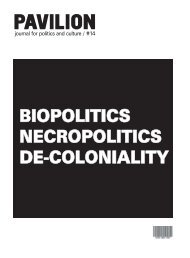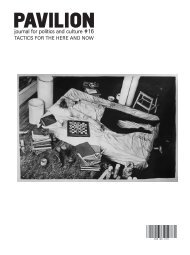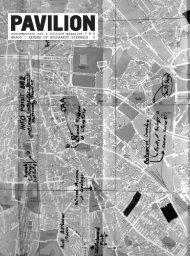PAVILION
PAVILION
PAVILION
- No tags were found...
Create successful ePaper yourself
Turn your PDF publications into a flip-book with our unique Google optimized e-Paper software.
like the market simply takes over from the<br />
state in providing for the basic needs of<br />
the population (which even the developers<br />
admit is impossible for the city as a<br />
whole), this scheme has built into it a<br />
curious urban and architectural contradiction.<br />
For it does not so much resolve<br />
the underlying class conflict as abstract it<br />
into a general principle. A vivid example<br />
of this is to be found in the pair of luxury<br />
high-rise residential towers designed by<br />
the architect Hafeez Contractor on a<br />
slum-rehabilitation site in Mumbai’s<br />
Tardeo neighborhood. This is not a particularly<br />
accomplished work of architecture,<br />
and indeed, for Hafeez Contractor architecture<br />
is a game that is played to win<br />
rather than a refined art form. In this<br />
case, the game involved making the SRA<br />
legislation work on the site by balancing<br />
the socio-economic demands of the luxury<br />
real estate market against the political<br />
demands of slum dwellers. The result is a<br />
monumental fissure running right through<br />
the site that divides the very wealthy from<br />
the very poor. The architecture of the<br />
building, which consists mainly of overwrought,<br />
neo-Deco ornamentation above<br />
and functionalist regimentation below, is<br />
used simultaneously to produce and to<br />
cover up this fissure. But more importantly,<br />
despite the domineering posture of the<br />
project’s twin towers, their architecture<br />
and that of the “rehabilitated” slum over<br />
which they hover stand starkly separated<br />
from one another not only for their contrast<br />
of garish to humble, but essentially,<br />
for their contrast of an architecture (that<br />
of the towers) that attempts to communicate<br />
and another architecture (that of the<br />
tenements) that does not.<br />
Conventionally, this would be described<br />
as a contrast of figurative to abstract. But<br />
it would be more accurate to describe the<br />
project’s stark, built-in divide as the result<br />
of an abstraction of another sort—a higher<br />
level of abstraction comparable to the<br />
abstractions of credit. Since credit, as we<br />
have just been reminded, is built around<br />
trust, belief, and a quasi-religious faith—<br />
in this case, the faith that the real estate<br />
market will resolve the city’s housing crisis.<br />
Moreover, the classic movement from<br />
use value to exchange value is turned on<br />
its head here. Exchange value, in the<br />
form of luxury real estate, is made to<br />
seem capable of yielding surplus use<br />
value, in the form of the utilitarian tenements.<br />
This inversion, which is also the<br />
principle according to which many “public-private”<br />
partnerships work, naturalizes<br />
the politico-economic proposition underlying<br />
the SRA legislation, by repositioning<br />
the slum dwellers (and by extension, the<br />
“public” at large) as beneficiaries from<br />
whom the markets ask only trust and<br />
faith. Enabled by the state, the market<br />
thus takes over as the biopolitical agent<br />
par excellence, and the slum dwellers are<br />
caught in a double bind of paternalism<br />
and primitive accumulation. In terms of<br />
urban realpolitik, they are also pitted<br />
against one another and forced to<br />
engage in Faustian bargaining for additional<br />
square feet based on the leverage<br />
acquired by holding out. Thus the slum<br />
rehabilitation scheme taken as a whole<br />
can be described as a fetish: a quasi-religious<br />
object with seemingly magical powers<br />
that, like Fuller’s equally metaphysical<br />
domes, is the product of rational calculation,<br />
rather than its opposite.<br />
---<br />
It is uncontroversial to suggest that, in<br />
cities like New York but also around the<br />
world, architecture has more generally<br />
become a kind fetish for the speculative<br />
real estate market. What may be more<br />
controversial is to say exactly what this<br />
means. Since for architecture, it means<br />
buildings that inspire faith. In other<br />
words, it means iconic buildings, the<br />
degraded form of which these Hafeez<br />
buildings are paradigmatic.<br />
The culture industry in which such buildings<br />
operate is managed aesthetically by<br />
a broad spectrum of producers, at the far<br />
end of which stand any number of “signature”<br />
architects, such as Jean Nouvel or<br />
Frank Gehry. And while the associated<br />
phenomenon of accomplished architects<br />
working with large developers is not particularly<br />
new, during the first decade of<br />
the twenty-first century it has been elevated<br />
to a new kind of norm. Rather than<br />
being the exception (marked, for example,<br />
by the association between I.M. Pei<br />
with the developer William Zeckendorf in<br />
the late 1950s), the thought that architecture<br />
as an art form is not only possible<br />
under the global real estate markets, but<br />
is actually stimulated by them, has<br />
become commonplace. The most articulate<br />
architect working on or around this<br />
problem remains Rem Koolhaas. But<br />
here too, even Koolhaas’s self-conscious<br />
irony is limited merely to reflecting the<br />
mainstream identification of architecture<br />
with finance capital, as in his firm’s imaginative<br />
yet quite accommodating parody<br />
of the market-driven desire to maximize<br />
residential floor areas under strict zoning<br />
regulations in a recent proposal for 23rd<br />
Street in Manhattan.<br />
Faced with such a juggernaut, we are<br />
forced to ask how architecture actually<br />
works—especially as an artwork<br />
designed for the urban real estate market<br />
by architects like Koolhaas. But I have<br />
already alluded to the beginnings of an<br />
answer, and therefore to the beginnings<br />
of what we might describe as a philosophy<br />
of the contemporary city written from<br />
an architectural perspective. Today,<br />
architecture still works the way it has for<br />
millennia: as a fetish, an object with special<br />
powers, the prime example of which<br />
is a religious object, like the hundreds of<br />
temples, churches, and other religious<br />
monuments that constitute the foundation<br />
of any given architectural canon, whether<br />
Western or otherwise.<br />
But what does it mean to understand the<br />
relationship between architecture and<br />
capital as, at least in part, a religious<br />
one? It means, again, that this relationship<br />
is not just a matter of patronage (the<br />
developer as client) or of analogy (that,<br />
say, the virtuality of contemporary architecture<br />
somehow mimics the virtuality of<br />
contemporary finance), though both of<br />
these are factors. Nor does it simply<br />
mean that Architecture (with a capital A),<br />
costly though it is, is now considered<br />
profitable, along the lines of a model<br />
promising higher returns per square foot<br />
that was actually invented in the 1980s in<br />
Houston by the developer Gerald Hines<br />
in collaboration with Philip Johnson.<br />
Instead, it means that, as with Hafeez<br />
Contractor’s SRA scheme, architecture<br />
has become more than just a useful<br />
object turned a commodity in the earlier,<br />
Marxian sense.<br />
Under the conditions of European industrialization,<br />
Simmel and his interpreters,<br />
including Frankfurt School critics like<br />
Benjamin and Kracauer, took up the<br />
increasing degrees of abstraction of the<br />
[268]<br />
[269]








